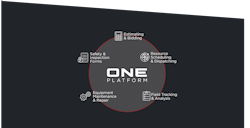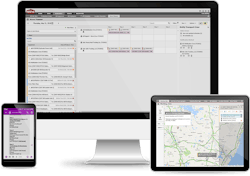'One Platform' Helps Contractors Manage Site Tasks
B2W’s One Platform construction software allows equipment managers to manage and estimate construction operations under one cohesive platform. The platform consists of several modules relevant to a manager’s tasks, and aims to help contractors win more bids at better margins.
Between tracking in the field, the maintenance department, and the scheduled jobs, the software allows users to see their production, target goals, track materials, and view the assets they have available to commit to jobs.
Daniel Corbett, equipment manager at Lancaster Development in New York, uses the B2W software to manage assets and ensure each is being used properly. Corbett says one of the most important functions the management tool can deliver is informing users of where their true costs are.
“I think a lot of construction companies and a lot of other companies have a rough idea of their true costs,” Corbett says. “Even then, they're unsure of a lot of different aspects.”
Corbett says he’s able to track costs through numerous reports One Platform compiles, helping him manage each one as it comes in. After purchasing a 50-ton excavator, for example, Corbett sets up the machine and its depreciation cycle within the platform. He also enters hourly rates to use the machine (fuel usage, etc.), in addition to adding what the manufacturer recommends for service intervals.
“We specifically set up what I call the ‘birth certificate’ within the platform,” he says. “That’s where I’ll enter the equipment type, the manufacturer, weight, and specs. Then we’ll set up what the OE recommends for service intervals from 250 hours to 6,000 hours.”
According to Corbett, entering this data is not only beneficial to tracking costs, but is also a starting point to developing a preventative maintenance (PM) program for each machine.
“As you get more of that type of equipment, especially if it's the same manufacturer, the platform lets you see trends in what fails and when it fails,” he says. “We’re tracking all the repairs made through the platform, and looking for recurrences in like equipment. That way the equipment isn’t being under-serviced, but you’re also not wasting manpower over-servicing it.”
Corbett also says the platform helps the company control assets. Lancaster’s machines have Trimble telematics systems installed on them, and each asset’s hours and location are imported into the One Platform every morning at 6 a.m.
“That data is constantly getting uploaded so they can see where the job is,” he says. “The platform also helps us keep track of the hours until the next service.”
Once the report comes in, Corbett is able to see whether or not owned equipment is being underutilized.
“There are a few pieces of equipment that need to be on a job, and they don't use them that often, but it's part of the cost of doing business,” he says. “But the bigger iron sitting there, especially if it's rental equipment, it's either use it or lose it. It's helped us to increase utilization and lower rental expenses.
“If owned equipment isn’t being used, but I’m renting like equipment, we’ll move our own piece to a job and remove the rental,” he says. “The platform gives us a better visual of what we actually need to have on rent. Far too often in the past we would rent equipment, it would stay out on a job, and you wouldn't have a real concept of utilization until the job was over.”
Users can also track goals for production rates on different facets of a project through the platform's scheduling module.
“That's real-time data,” Corbett says. “If we had planned on doing 1,000 yards of blacktop a day, for example, and we're not reaching that goal, we have an opportunity to drill down to the reasons why and make a correction before you've lost that part of the job.”
Corbett’s superintendents are also able to see whether or not a machine is available for a job through the scheduling module. This helps the company manage scheduling, and gives workers the ability to forecast equipment needs.
“If a machine is in the shop, we put its projected downtime into the platform, and the superintendent can try to coordinate around that on their job,” Corbett says. “Or we would have to rent something until that machine is back up.”
Coupling asset management with the scheduling module has also given workers the ability to claim pieces of equipment ahead of time. Lancaster superintendents are required to enter any equipment they will need on a job two weeks in advance.
“If a superintendent knows he's going to need a 30-ton excavator in two weeks, he puts in a request for the machine on his job, and when he needs it there by,” Corbett says. “They try to give us an approximate end date, which helps us plan better on what assets to give them.”
Scheduling in advance also gives workers the ability to service the machine or make repairs before it’s on the job.
“It also helps us to coordinate repairs or services around their schedule so we’re not disrupting operations,” he says.
Corbett says overall, the One Platform has made a significant impact at Lancaster. Instead of using antiquated processes to track machines, the entire team now has full job visibility anytime and anywhere.
“We used to use a whiteboard with little equipment magnets on it, and each part of the board was a location,” he says. “Now, I think it's important to have the One Platform’s visual to associate to what's going on real time in your shop or in the field.”

